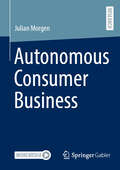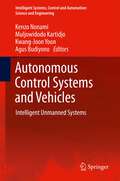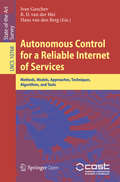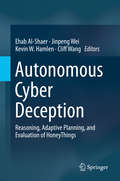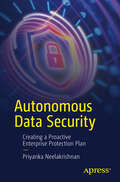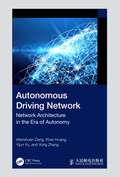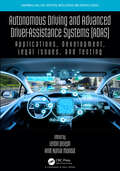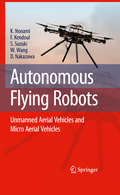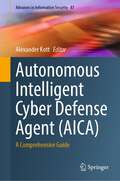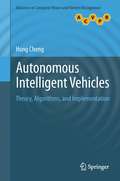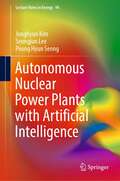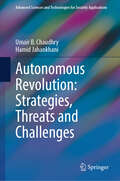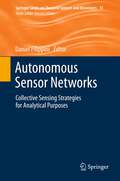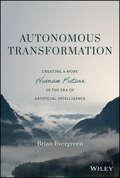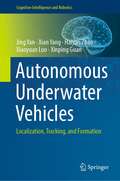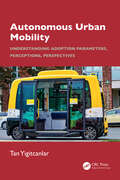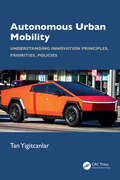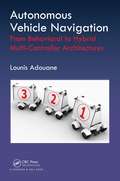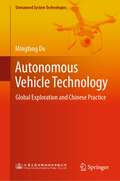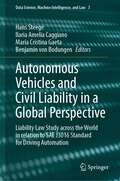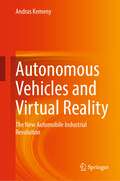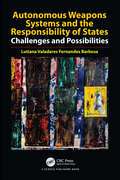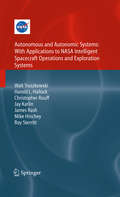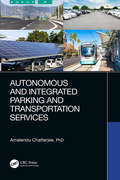- Table View
- List View
Autonomous Consumer Business
by Julian MorgenEine immer mehr digital vernetzte Welt führt zu einer sehr großen Menge von unterschiedlichen Daten, die in Echtzeit generiert werden („Big Data“). Ein großer Teil dieser Datenproduzenten sind Nutzer von Social Media oder auch smarten Geräten, wie bspw. Fitnesstrackern oder mit dem Internet verbundenen Waschmaschinen („IoT“). Unternehmen, die sich diese Daten aus der direkten Lebenswelt der Konsumenten zu Nutze machen, können sehr präzise Einblicke bspw. über Einstellungen, Verhalten oder auch die Bedürfnisse potenzieller Kunden erhalten, wodurch der Weg zu einer „automatisierten Vermarktung“ geebnet wird. Zielsetzung dieses Buches ist die Entwicklung eines Konzeptes für ein Autonomous Consumer Business (ACB), das als maximal eigenständig agierendes und durch Künstliche Intelligenz getragenes Geschäftsmodell verstanden wird, bei dem Unternehmen die Bedürfnisse auf der Konsumentenseite automatisch erkennen und durch entsprechende Leistungsangebote befriedigen können. Weiterhin werden zentrale Bestimmungsgrößen, welche die konsumentenseitige Inanspruchnahme eines ACB im besonderen Maße beeinflussen, sowie potenzielle Kundengruppen empirisch identifiziert, wodurch Hinweise zur konkreten Ausgestaltung eines ACB gewonnen werden können.
Autonomous Control Systems and Vehicles: Intelligent Unmanned Systems (Intelligent Systems, Control and Automation: Science and Engineering #65)
by Kenzo Nonami Agus Budiyono Kwang-Joon Yoon Muljowidodo KartidjoThe International Conference on Intelligent Unmanned Systems 2011 was organized by the International Society of Intelligent Unmanned Systems and locally by the Center for Bio-Micro Robotics Research at Chiba University, Japan. The event was the 7th conference continuing from previous conferences held in Seoul, Korea (2005, 2006), Bali, Indonesia (2007), Nanjing, China (2008), Jeju, Korea (2009), and Bali, Indonesia (2010). ICIUS 2011 focused on both theory and application, primarily covering the topics of robotics, autonomous vehicles, intelligent unmanned technologies, and biomimetics. We invited seven keynote speakers who dealt with related state-of-the-art technologies including unmanned aerial vehicles (UAVs) and micro air vehicles (MAVs), flapping wings (FWs), unmanned ground vehicles (UGVs), underwater vehicles (UVs), bio-inspired robotics, advanced control, and intelligent systems, among others. This book is a collection of excellent papers that were updated after presentation at ICIUS2011. All papers that form the chapters of this book were reviewed and revised from the perspective of advanced relevant technologies in the field. The aim of this book is to stimulate interactions among researchers active in the areas pertinent to intelligent unmanned systems.
Autonomous Control for a Reliable Internet of Services: Methods, Models, Approaches, Techniques, Algorithms, and Tools (Lecture Notes in Computer Science #10768)
by Ivan Ganchev R. D. van der Mei Hans van den BergThis open access book was prepared as a Final Publication of the COST Action IC1304 “Autonomous Control for a Reliable Internet of Services (ACROSS)”. The book contains 14 chapters and constitutes a show-case of the main outcome of the Action in line with its scientific goals. It will serve as a valuable reference for undergraduate and post-graduate students, educators, faculty members, researchers, engineers, and research strategists working in this field. The explosive growth of the Internet has fundamentally changed the global society. The emergence of concepts like SOA, SaaS, PaaS, IaaS, NaaS, and Cloud Computing in general has catalyzed the migration from the information-oriented Internet into an Internet of Services (IoS). This has opened up virtually unbounded possibilities for the creation of new and innovative services that facilitate business processes and improve the quality of life. However, this also calls for new approaches to ensuring the quality and reliability of these services. The objective of this book is, by applying a systematic approach, to assess the state-of-the-art and consolidate the main research results achieved in this area.
Autonomous Cyber Deception: Reasoning, Adaptive Planning, and Evaluation of HoneyThings
by Cliff Wang Ehab Al-Shaer Jinpeng Wei Kevin W. HamlenThis textbook surveys the knowledge base in automated and resilient cyber deception. It features four major parts: cyber deception reasoning frameworks, dynamic decision-making for cyber deception, network-based deception, and malware deception. An important distinguishing characteristic of this book is its inclusion of student exercises at the end of each chapter. Exercises include technical problems, short-answer discussion questions, or hands-on lab exercises, organized at a range of difficulties from easy to advanced,. This is a useful textbook for a wide range of classes and degree levels within the security arena and other related topics. It’s also suitable for researchers and practitioners with a variety of cyber security backgrounds from novice to experienced.
Autonomous Data Security: Creating a Proactive Enterprise Protection Plan
by Priyanka NeelakrishnanThis book focuses on analyzing the foundational requirements necessary to construct an autonomous data protection solution for enterprise businesses. It navigates readers through various options and tools, outlining the advantages and disadvantages of each. Covering diverse deployment environments including cloud, on-premises, and hybrid setups, as well as different deployment scales and comprehensive channel coverages, it encourages readers to break away from conventional norms in their approach. By exploring the factors that should be taken into account, the book highlights the significant gap in existing data safeguarding solutions, which often rely solely on configured security policies. It proposes a forward-thinking security approach designed to endure over time, surpassing traditional policies and urging readers to consider proactive autonomous data security solutions. Additionally, it delves into the system's ability to adapt to deployed environments, learn from feedback, and autonomously safeguard data while adhering to security policies. More than just a set of guidelines, this book serves as a catalyst for the future of the cybersecurity industry. Its focus on autonomous data security and its relevance in the era of advancing AI make it particularly timely and essential. What You Will learn: Understand why data security is important for enterprise businesses. How data protection solutions work and how to evaluate a solution in the market. How to start thinking and evaluating requirements when building a solution for small, medium, and large enterprises. Understand the pros and cons of security policy configurations defined by administrators and why can’t they provide comprehensive protection. How to safeguard data via adaptive learning from the deployed environment – providing autonomous data security with or without policies. How to leverage AI to provide data security with comprehensive proactive protection. What factors to consider when they have to protect and safeguard data. Who this book is for: The primary audience is cybersecurity professionals, security enthusiasts, C-level executives in organizations (all verticals), and security analysts and IT administrators. Secondary audience includes professors and teachers, channel integrators, professional services, and hackers.
Autonomous Driving Network: Network Architecture in the Era of Autonomy
by Yong Zhang Yijun Yu Wenshuan Dang River HuangAiming to outline the vision of realizing automated and intelligent communication networks in the era of intelligence, this book describes the development history, application scenarios, theories, architectures, and key technologies of Huawei's Autonomous Driving Network (ADN) solution. In the book, the authors explain the design of the top-level architecture, hierarchical architecture (ANE, NetGraph, and AI Native NE), and key feature architecture (distributed AI and endogenous security) that underpin Huawei's ADN solution. The book delves into various key technologies, including trustworthy AI, distributed AI, digital twin, network simulation, digitization of knowledge and expertise, human-machine symbiosis, NE endogenous intelligence, and endogenous security. It also provides an overview of the standards and level evaluation methods defined by industry and standards organizations, and uses Huawei's ADN solution as an example to illustrate how to implement AN. This book is an essential reference for professionals and researchers who want to gain a deeper understanding of automated and intelligent communication networks and their applications.
Autonomous Driving Perception: Fundamentals and Applications (Advances in Computer Vision and Pattern Recognition)
by Rui Fan Sicen Guo Mohammud Junaid BocusDiscover the captivating world of computer vision and deep learning for autonomous driving with our comprehensive and in-depth guide. Immerse yourself in an in-depth exploration of cutting-edge topics, carefully crafted to engage tertiary students and ignite the curiosity of researchers and professionals in the field. From fundamental principles to practical applications, this comprehensive guide offers a gentle introduction, expert evaluations of state-of-the-art methods, and inspiring research directions. With a broad range of topics covered, it is also an invaluable resource for university programs offering computer vision and deep learning courses. This book provides clear and simplified algorithm descriptions, making it easy for beginners to understand the complex concepts. We also include carefully selected problems and examples to help reinforce your learning. Don't miss out on this essential guide to computer vision and deep learning for autonomous driving.
Autonomous Driving and Advanced Driver-Assistance Systems: Applications, Development, Legal Issues, and Testing (Chapman & Hall/CRC Artificial Intelligence and Robotics Series)
by Lentin JosephAutonomous Driving and Advanced Driver-Assistance Systems (ADAS): Applications, Development, Legal Issues, and Testing outlines the latest research related to autonomous cars and advanced driver-assistance systems, including the development, testing, and verification for real-time situations of sensor fusion, sensor placement, control algorithms, and computer vision. Features: Co-edited by an experienced roboticist and author and an experienced academic Addresses the legal aspect of autonomous driving and ADAS Presents the application of ADAS in autonomous vehicle parking systems With an infinite number of real-time possibilities that need to be addressed, the methods and the examples included in this book are a valuable source of information for academic and industrial researchers, automotive companies, and suppliers.
Autonomous Flying Robots: Unmanned Aerial Vehicles and Micro Aerial Vehicles
by Wei Wang Daisuke Nakazawa Farid Kendoul Kenzo Nonami Satoshi SuzukiWorldwide demand for robotic aircraft such as unmanned aerial vehicles (UAVs) and micro aerial vehicles (MAVs) is surging. Not only military but especially civil applications are being developed at a rapid pace. Unmanned vehicles offer major advantages when used for aerial surveillance, reconnaissance, and inspection in complex and inhospitable environments. UAVs are better suited for dirty or dangerous missions than manned aircraft and are more cost-effective. UAVs can operate in contaminated environments, for example, and at altitudes both lower and higher than those typically traversed by manned aircraft. Many technological, economic, and political factors have encouraged the development and operation of UAVs. New sensors, microprocessors, and propulsion systems are smaller, lighter, and more capable, leading to levels of endurance, efficiency, and autonomy that exceed human capacities. Comprising the latest research, this book describes step by step the development of small or miniature unmanned aerial vehicles and discusses in detail the integrated prototypes developed at the robotics laboratory of Chiba University. With demonstration videos, the book will interest not only graduate students, scientists, and engineers but also newcomers to the field.
Autonomous Intelligent Cyber Defense Agent: A Comprehensive Guide (Advances in Information Security #87)
by Alexander KottThis book offers a structured overview and a comprehensive guide to the emerging field of Autonomous Intelligent Cyber Defense Agents (AICA). The book discusses the current technical issues in autonomous cyber defense and offers information on practical design approaches. The material is presented in a way that is accessible to non-specialists, with tutorial information provided in the initial chapters and as needed throughout the book. The reader is provided with clear and comprehensive background and reference material for each aspect of AICA.Today’s cyber defense tools are mostly watchers. They are not active doers. They do little to plan and execute responses to attacks, and they don’t plan and execute recovery activities. Response and recovery – core elements of cyber resilience – are left to human cyber analysts, incident responders and system administrators. This is about to change. The authors advocate this vision, provide detailed guide to how such a vision can be realized in practice, and its current state of the art.This book also covers key topics relevant to the field, including functional requirements and alternative architectures of AICA, how it perceives and understands threats and the overall situation, how it plans and executes response and recovery, how it survives threats, and how human operators deploy and control AICA. Additionally, this book covers issues of testing, risk, and policy pertinent to AICA, and provides a roadmap towards future R&D in this field.This book targets researchers and advanced students in the field of cyber defense and resilience. Professionals working in this field as well as developers of practical products for cyber autonomy will also want to purchase this book.
Autonomous Intelligent Vehicles: Theory, Algorithms, and Implementation (Advances in Computer Vision and Pattern Recognition)
by Hong ChengThis important text/reference presents state-of-the-art research on intelligent vehicles, covering not only topics of object/obstacle detection and recognition, but also aspects of vehicle motion control. With an emphasis on both high-level concepts, and practical detail, the text links theory, algorithms, and issues of hardware and software implementation in intelligent vehicle research. Topics and features: presents a thorough introduction to the development and latest progress in intelligent vehicle research, and proposes a basic framework; provides detection and tracking algorithms for structured and unstructured roads, as well as on-road vehicle detection and tracking algorithms using boosted Gabor features; discusses an approach for multiple sensor-based multiple-object tracking, in addition to an integrated DGPS/IMU positioning approach; examines a vehicle navigation approach using global views; introduces algorithms for lateral and longitudinal vehicle motion control.
Autonomous Nuclear Power Plants with Artificial Intelligence (Lecture Notes in Energy #94)
by Poong Hyun Seong Jonghyun Kim Seungjun LeeThis book introduces novel approaches and practical examples of autonomous nuclear power plants that minimize operator intervention. Autonomous nuclear power plants with artificial intelligence presents a framework to enable nuclear power plants to autonomously operate and introduces artificial intelligence (AI) techniques to implement its functions. Although nuclear power plants are already highly automated to reduce human errors and guarantee the reliability of system operations, the term “autonomous” is still not popular because AI techniques are regarded as less proven technologies. However, the use of AI techniques and the autonomous operation seems unavoidable because of their great advantages, especially, in advanced reactors and small modular reactors.The book includes the following topics:Monitoring, diagnosis, and prediction.Intelligent control.Operator support systems.Operator-autonomous system interaction.Integration into the autonomous operation system. This book will provides useful information for researchers and students who are interested in applying AI techniques in the fields of nuclear as well as other industries. This book covers broad practical applications of AI techniques from the classical fault diagnosis to more recent autonomous control. In addition, specific techniques and modelling examples are expected to be very informative to the beginners in the AI studies.
Autonomous Revolution: Strategies, Threats and Challenges (Advanced Sciences and Technologies for Security Applications)
by Hamid Jahankhani Umair B. ChaudhryThis book offers a comprehensive dive into the rapidly evolving world of autonomous vehicles and their pivotal role in modern data collection and mission-critical operations. From unmanned vehicles (UVs) navigating complex urban landscapes to traversing remote environments, the integration of advanced algorithms and cloud-based infrastructure enables real-time data acquisition and processing. Topics covered include resilient navigation systems, bio-inspired evolution for safer collaboration, and the crucial governance and security challenges facing land, air, and sea-based UVs. Additionally, the book explores emerging threats, such as cyber-physical vulnerabilities, counter-drone technologies, and the need for secure Flying Ad-Hoc Networks (FANETs). The future of UVs is further examined through the lens of quantum computing, pushing the boundaries of autonomous navigation and decision-making. By compiling these scattered and essential topics into one resource, this book serves as a vital reference for professionals, researchers, and policymakers seeking to understand and shape the future of autonomous systems.
Autonomous Sensor Networks: Collective Sensing Strategies for Analytical Purposes (Springer Series on Chemical Sensors and Biosensors #13)
by Daniel FilippiniThis volume surveys recent research on autonomous sensor networks from the perspective of enabling technologies that support medical, environmental and military applications. State of the art, as well as emerging concepts in wireless sensor networks, body area networks and ambient assisted living introduce the reader to the field, while subsequent chapters deal in depth with established and related technologies, which render their implementation possible. These range from smart textiles and printed electronic devices to implanted devices and specialized packaging, including the most relevant technological features. The last four chapters are devoted to customization, implementation difficulties and outlook for these technologies in specific applications.
Autonomous Transformation: Creating a More Human Future in the Era of Artificial Intelligence
by Brian EvergreenFrom technologist and strategist Brian Evergreen, a bold new agenda for the role of organizational leaders in creating a more human future with technology Social good initiatives are incompatible with the current network of systems that make up and support the private and public sectors. Millions of dollars have been invested in bringing leaders together from organizations around the world to design solutions for global challenges such as the climate crisis, child labor, racism, war, and many more. Despite executive buy-in, alignment of core capabilities and resources, passionate leadership, and well-designed strategies, these initiatives inevitably fail (with a few, notable exceptions). The dawn of the Internet ignited a global redesign and rebuild of the interlocking systems that make up and support the private and public sectors today. The era of Digital Transformation extended this further through the adoption of cloud technologies and distributed computing. With a recent wave of technological advancements, organizations have arrived at another global redesign and rebuilding of the network of systems that make up society: Autonomous Transformation, revealing an opportunity for leaders to create Profitable Good through systemic design in combination with emerging autonomous technologies and surprising and remarkable partnerships. Autonomous Transformation provides a blueprint for leaders and managers who have aspired or attempted to harness artificial intelligence and its adjacent technologies for the betterment of their organization and the world, weaving strategy, business, economics, systemic design, and philosophy into four actionable steps with accompanying frameworks: Clear the Digital Fog See the Systems Choose a Problem Future Design Inevitability
Autonomous Underwater Vehicles: Localization, Tracking, and Formation (Cognitive Intelligence and Robotics)
by Xinping Guan Xian Yang Jing Yan Haiyan Zhao Xiaoyuan LuoAutonomous underwater vehicles (AUVs) are emerging as a promising solution to help us explore and understand the ocean. The global market for AUVs is predicted to grow from 638 million dollars in 2020 to 1,638 million dollars by 2025 – a compound annual growth rate of 20.8 percent. To make AUVs suitable for a wider range of application-specific missions, it is necessary to deploy multiple AUVs to cooperatively perform the localization, tracking and formation tasks. However, weak underwater acoustic communication and the model uncertainty of AUVs make achieving this challenging. This book presents cutting-edge results regarding localization, tracking and formation for AUVs, highlighting the latest research on commonly encountered AUV systems. It also showcases several joint localization and tracking solutions for AUVs. Lastly, it discusses future research directions and provides guidance on the design of future localization, tracking and formation schemes for AUVs. Representing a substantial contribution to nonlinear system theory, robotic control theory, and underwater acoustic communication system, this book will appeal to university researchers, scientists, engineers, and graduate students in control theory and control engineering who wish to learn about the core principles, methods, algorithms, and applications of AUVs. Moreover, the practical localization, tracking and formation schemes presented provide guidance on exploring the ocean. The book is intended for those with an understanding of nonlinear system theory, robotic control theory, and underwater acoustic communication systems.
Autonomous Urban Mobility: Understanding Adoption Parameters, Perceptions, Perspectives
by Tan YigitcanlarThis book delves into the complex landscape of autonomous urban mobility, analysing the factors that influence public adoption, stakeholder perspectives, and societal perceptions in this rapidly evolving field. Aimed at scholars, policymakers, urban planners, and industry professionals, this book offers a thorough exploration of the key elements driving the integration of autonomous vehicles in urban settings. Drawing on empirical evidence from diverse case studies, it first investigates public awareness, emphasising the roles of knowledge, exposure, and media in shaping perceptions of autonomous vehicles, and underscores the critical need for targeted awareness campaigns. Subsequent chapters examine pre-trial attitudes towards autonomous shuttles, demonstrating how initial experiences significantly impact adoption willingness, and advocate for pilot programs to cultivate informed, positive perceptions.This book also explores the potential of smart mobility solutions to bridge first/last mile gaps, presenting data on how autonomous vehicles can improve urban transport efficiency and accessibility. By analysing socio-demographic predictors, it highlights varying perceptions of the benefits and challenges of autonomous demand-responsive transit, underscoring the importance of tailored strategies for diverse urban populations. Stakeholder perspectives, gathered through interviews and case studies, offer practical recommendations for overcoming technological, regulatory, and societal hurdles. Comparative insights from international case studies broaden the understanding of local factors influencing autonomous vehicle acceptance, while advanced modelling techniques identify the key drivers of driverless car adoption. Finally, this book explores the transformative potential of autonomous vehicles in developing countries, offering visionary insights into their capacity to reshape urban landscapes.With its data-rich content and forward-thinking analysis, this book is an indispensable guide to the future of urban transportation and the critical role of autonomous mobility.This volume, alongside its companion—Autonomous Urban Mobility: Understanding Innovation Principles, Priorities, Policies—offers a holistic view of autonomous urban mobility. Together, these books provide a comprehensive exploration of the rapidly evolving landscape of autonomous urban mobility, the principles guiding its innovation, the wide-ranging impacts of its adoption on society, policy, and urban environments, and the transformative potential of autonomous vehicles in the future of urban transportation.
Autonomous Urban Mobility: Understanding Innovation Principles, Priorities, Policies
by Tan YigitcanlarThis book provides a comprehensive exploration of the rapidly evolving field of autonomous urban mobility, examining its transformative potential and the principles guiding its innovation. This essential resource offers deep insights into the societal, policy, and urban impacts of autonomous vehicles, drawing on an extensive body of research. Beginning with a review of smart urban mobility innovations, the book explores technological advancements such as connected vehicles, mobility-as-a-service platforms, and shared autonomous systems, evaluating their successes and challenges.This book traces the evolution of autonomous vehicle research over the past two decades, identifying key trends, methodologies, and future research directions, underscoring the importance of interdisciplinary approaches to address complex challenges. Subsequent chapters critically assess the technical capabilities, societal impacts, and policy frameworks necessary for the widespread adoption of autonomous vehicles, with a focus on implications for land use, infrastructure, and environmental planning. Public acceptance is a recurring theme, with an in-depth analysis of socio-demographic, psychological, and contextual factors influencing attitudes towards autonomous mobility. This book also examines the role of shared autonomous systems in addressing urban challenges such as congestion and equity, highlighting their potential to create more sustainable urban transportation networks. Concluding with a discussion on the disruptive impacts of autonomous vehicles on urban form and land use, the author provides a balanced perspective on the opportunities and risks of mobility-as-a-service.This key reference book equips academics, policymakers, urban planners, and industry professionals with the knowledge to navigate the complex interplay of technology, policy, and societal impact, advancing the vision of smarter and more sustainable cities.This volume, alongside its companion—Autonomous Urban Mobility: Understanding Adoption Parameters, Perceptions, Perspectives—offers a holistic view of autonomous urban mobility. Together, these books provide a comprehensive exploration of the rapidly evolving landscape of autonomous urban mobility, the principles guiding its innovation, the wide-ranging impacts of its adoption on society, policy, and urban environments, and the transformative potential of autonomous vehicles in the future of urban transportation.
Autonomous Vehicle Navigation: From Behavioral to Hybrid Multi-Controller Architectures
by Lounis AdouaneImprove the Safety, Flexibility, and Reliability of Autonomous Navigation in Complex EnvironmentsAutonomous Vehicle Navigation: From Behavioral to Hybrid Multi-Controller Architectures explores the use of multi-controller architectures in fully autonomous robot navigation-even in highly dynamic and cluttered environments. Accessible to researchers
Autonomous Vehicle Technology: Global Exploration and Chinese Practice (Unmanned System Technologies)
by Mingfang DuThe subject of this book is artificial intelligence (AI), introducing the fast road sensing algorithm and system based on image pattern recognition for unmanned vehicle, especially for traffic sign recognition and complex road recognition. With rich figures and credible data, this book systematically and comprehensively describes the core technology and industrialization focus of today's unmanned vehicle system, which can be used as a reference for R & D Engineers and industrialization practitioners of unmanned vehicle, and it can also be used as a teaching material for higher grades and postgraduates in colleges and universities.
Autonomous Vehicles and Civil Liability in a Global Perspective: Liability Law Study across the World in relation to SAE J3016 Standard for Driving Automation (Data Science, Machine Intelligence, and Law #3)
by Hans Steege Ilaria Amelia Caggiano Maria Cristina Gaeta Benjamin Von BodungenIn the automotive sector, digitalisation, connectivity and automation are rapidly expanding. In tomorrow’s vehicles, human beings will merely be passengers – which raises a host of complex legal issues regarding accidents involving self-driving vehicles. This book is the first to offer a comprehensive, global overview of civil liability regimes for all levels of vehicle automation in jurisdictions that represent some of the most important markets for the automotive industry. After a technical introduction to how self-driving cars work, the individual chapters analyse the liability for driving automation at SAE J3016 levels 0 through 5 from a country-specific perspective. All chapters were written by experts in the field and follow a uniform legal structure. Hence, the book offers an essential comparative analysis of similarities and differences in the jurisdictions examined, while also providing suggestions for future legislative changes at the national and international level. The book is not only relevant for legal scholars and practitioners but will also be of particular interest to anyone involved in the design, manufacture, distribution and operation of self-driving vehicles.
Autonomous Vehicles and Virtual Reality: The New Automobile Industrial Revolution
by Andras KemenyThis book concisely describes the technologies, human perception, and cognition issues relevant to autonomous vehicles. It also gives an insight in the changes bring about our future everyday lives.Autonomous vehicles are the future of the automobile industry. Automated driving (AD), also called self-driving, raises however several multiple questions, among them those of user safety and acceptation. Comprehensive HMI system design, with windshield display technics, will be necessary to deal with driving task delegations, bringing the use of VR or augmented reality (AR) technologies. In addition, the use of VR for all the vehicle interiors will progressively be proposed for entertainment, online business activities and for modified visual motion perception to alleviate car sickness, a form of motion sickness. Indeed, car sickness is already well known for many passengers, especially when reading or operating smartphones or other display devices. It is called to increase significantly with the introduction of autonomous vehicles where all users will be for long periods in various sitting positions. These two new trends, AD and VR, are already modifying our relationship with the world and the society. All together, they will change our way of life forever. The book will be of interest to professionals in the auto industry, researchers in automotive engineering and computer science and all those interested in the future of transport.
Autonomous Weapons Systems and the Responsibility of States: Challenges and Possibilities
by Lutiana Valadares Fernandes BarbosaThis book reviews whether the existing framework in place can effectively address breaches in the context of Autonomous Weapons Systems (AWS). The work endeavors to map out the main gaps and some possible approaches to address them. Part I sets the ground. First, it provides a concept of AWS. Next, it discusses the accountability gap AWS generate and shows how the international community has put far more emphasis on individual responsibility rather than state responsibility. Part II analyzes the challenges AWS pose to the regime governing state responsibility under international law, as codified in the Draft Articles on State Responsibility (ARSIWA). In this regard, it discusses attribution, breach of an international obligation, tempus comissi delicti, multiple states involved in a breach, force majeure, assurance of non-repetition, issues related to damage, the human-machine interaction and its impacts on state´s responsibility, responsibility for not using AWS, weapons review and the duty of due diligence. Part III summarizes the challenges discussed in part II in thirteen issues of concern and presents possible paths de lege ferenda to address each of those issues, mainly a paradigm shift in attribution and strict liability, among seven other more specific proposals. The conclusion reached is that the current regime on the international responsibility of states is insufficient to deal with the new challenges AWS pose. De lege ferenda, the book argues for following the paths suggested in part III. It also reflects on parts II and III's findings and how many of AWS's challenges to state´s responsibility apply to other autonomous devices. Therefore, through the case study of AWS, this work also opens the broader discussion of the gaps in the international responsibility of states regarding autonomous device misdoings.
Autonomous and Autonomic Systems: With Applications To Nasa Intelligent Spacecraft Operations And Exploration Systems (NASA Monographs in Systems and Software Engineering)
by Christopher Rouff Michael Hinchey Walt Truszkowski James Rash Jay Karlin Roy Sterritt Harold HallockThis book provides an in-depth discussion of autonomous and autonomic systems, their interdependencies, differences and similarities. Current and pending issues in these evermore increasingly important subjects are highlighted and discussed. Concepts, ideas and experiences are explored in relation to real-life NASA systems in spacecraft control and in the exploration domain.
Autonomous and Integrated Parking and Transportation Services
by Amalendu ChatterjeeIn this book, the author outlines a Robust Web Parking, Truck and Transportation Portal (RWPTTP) for integrating parking and transportation services – a revolutionary approach in contrast to incremental change for managing traffic congestion. Autonomous vehicle technology, artificial intelligence, internet of things (IOT), and other interconnected hardware and software tools will assist autonomous parking and transportation services and provide next-century infrastructure for consolidated transportation customer services. The book highlights currently available autonomous parking and transportation technologies, and the development of an integrated and intelligent transportation service/system (IITS) platform, with specific use of technologies to reconfigure the transportation industry. The author also suggests many regulatory and policy changes to simplify data collection, traffic operation, introduction of a duplicate transportation system using light rail (LRs) and high speed rail (SPRs), and redistribution of parking spaces along such routes, using renewable energy.
